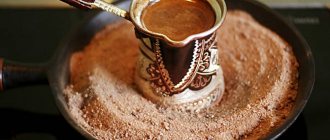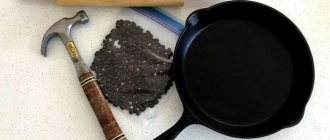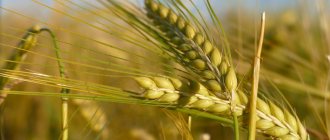Care after purchase
So, how to grow Arabica coffee at home? The coffee tree is famous for its unpretentiousness, but this does not mean that it does not need care and the creation of the necessary conditions.
REFERENCE! The first thing you should think about before purchasing is whether your apartment has the space needed for the tree. The fact is that Arabica can grow to the size of a two-meter bush.
Position the plant so that the sun's rays do not directly hit the leaves. Contact with sunlight can cause burns on tender leaves. At the same time, Arabica loves bright lighting, preferably a little diffused.
If there is a lack of natural light, you can install phytolamps. This will create additional lighting. Coffee will feel most comfortable on windows facing east or west.
ATTENTION! Arabica is native to the tropical lands of Asia and Africa. It is there that this species grows wild. The climate in Russia is unsuitable for coffee, so attempts to create a plantation on your own estate will not achieve the expected result. Arabica will not survive the cold season.
Watering
Arabica has an active period and a period when the plant goes dormant.
The active period occurs in the warm part of the year, from approximately March to October. At this time, Arabica needs the soil to constantly maintain moisture and not dry out. During hibernation, water consumption decreases.
It is better to pre-settle water for irrigation or use filtered purified water.
REFERENCE! In an effort to maintain soil moisture, you cannot overdo it and create an artificial swamp. If you overdo it with moisture, there is a danger of rotting of the root system.
Feeding should be done during the active period. Fertilizer should be added to the water for irrigation once a week.
ATTENTION! The fertilizer should not contain calcium.
During the cold season, a period of rest begins. During this period, watering should be reduced. It should also be taken into account that in winter evaporation occurs with less intensity than in summer.
REFERENCE! In addition to watering, Arabica requires constant spraying. The humidity in the room is of great importance for the plant. It is especially important to spray leaves during the heating season, when the air in apartments becomes especially dry.
Bloom
Coffee blooms in a delicate white color. The thin petals of the Arabica coffee flower exude a rich, pleasant aroma. As a rule, the flowering of the Arabica coffee tree begins in the third or even fourth year of life.
Subsequently, the flowers give way to small round red fruits. If, upon reaching the specified period, flowers do not appear on the tree, then you need to check whether the plant is being cared for correctly.
ATTENTION! Proper lighting is important for the coffee tree to bloom. The reason for the lack of flowers may be a lack of light.
Below are photos of Arabica coffee; caring for it at home allows you to achieve the following results:
Priming
For Arabica, slightly acidic soil is most suitable. If it is not possible to purchase a ready-made soil mixture for a coffee tree, you can use mixtures for plants that also prefer acidic and slightly acidic soil. These plants include azalea or hydrangea.
REFERENCE! Before planting your coffee tree, make sure the pot you choose is the right size. A thick drainage layer should be placed on the bottom. This is a prerequisite for all plants that require abundant watering. If the drainage layer is sufficient, then water will not linger near the roots and will not create a risk of rotting.
Transfer
Young coffee trees need to be replanted annually.
The best time of year for transplantation is spring .
When the plant reaches a large size and stops growing, the need for regular replanting disappears.
It is enough to replace the top soil annually.
Arabica coffee - caring for a houseplant at home
Many amateur flower growers dream of having a coffee tree in their collection. Some of them believe that only specialists can cultivate it. However, this is a misconception. Arabica coffee is a houseplant that can be grown at home on a windowsill if you provide the plant with proper care.
Arabica coffee is a perennial shrub or small tree from the Rubiaceae genus. Its homeland is Africa or Asia; it is currently grown in many countries around the world.
The flower is distinguished by thick, bright green, shiny foliage. The leaf blades are sharp at the ends, with well-defined veins. The branches-trunks are slender, thin and at the same time very flexible. They can reach 15 cm in height.
But most of all, the coffee plant is loved for its flowers, which look like small stars, very reminiscent of jasmine flowers. These white petals with an incredibly pleasant aroma can be seen in the spring when the buds bloom.
They bloom for only a couple of days. And after 6 months, red or black fruits appear in this place. In their shape they resemble cherries, but oblong. Each “cherry” produces two coffee beans. They are what delight coffee lovers in the morning.
Reproduction and cultivation
The coffee tree propagates by seeds or propagation occurs by cuttings. The shoots are placed in a mixture of sand and peat. The root system is formed within two months.
ATTENTION! To speed up the emergence of the root system in the cuttings, growth stimulants can be used. An important factor is the temperature, which should not be lower than 28 degrees.
Arabica seeds can be purchased at the store or you can use ripe, unroasted beans. The grain is covered with a hard and durable shell; in order to speed up the germination process, the grain should be kept in a solution of hydrochloric acid. After planting, it is recommended to use growth stimulants.
Temperature
Temperature conditions are very important for keeping Arabica at home. Since the plant is heat-loving, it should be remembered that low temperatures can have a detrimental effect. The optimal temperature in winter is 16 degrees.
REFERENCE! For a coffee tree, the unacceptable temperature is below 12 degrees.
Benefits and harms
Arabica beans have long been used by humans not only to create an aromatic and invigorating drink, but also in folk medicine. Coffee contains caffeine, which has a stimulating effect on the cardiovascular system.
This drink can not only be beneficial, but also be dangerous.
Doctors advise people with a rapidly excitable nervous system, pregnant women and those suffering from diseases of the cardiovascular system to abstain from coffee or drink it in moderate doses.
What does coffee look like?
Arabica coffee (coffea arabica) is a perennial shrub or compact tree belonging to the Rubiaceae family. Its homeland is Africa and Asia, but it is grown under cultural and domestic conditions in many countries. The tree can reach a height of 1.5 m. Coffee has a thick, lush crown, rich green leaves, oblong-pointed, up to 15 cm long. They are located oppositely on flexible, slightly branching shoots. The surface of the leaves is glossy, with well-defined veins. The root system of the Arabica coffee plant is branched, with a long central root.
Flowers and fruits are especially decorative. The flowers of the coffee tree are star-shaped, reminiscent of jasmine, the petals are white, with a strong pleasant aroma, collected in inflorescences of 3-6 pieces. The buds begin to bloom in the spring. The plant fades quickly, after 1-2 days. After six months, fruits are formed in their place, shaped like oblong cherries. They are usually red or black. Each cherry contains 2 coffee beans.
Scientific name
The coffee tree may be called simply Coffee for short. This plant species belongs to the Madder family. There are more than 70 different types of coffee. The most famous types:
- Arabian, also called Arabica;
- Bengal;
- Robusta, or Congolese;
- Cameroonian;
- Liberian.
The following tree-like indoor plants are also grown at home: Ficus “Eden”, “Black Prince”, “Bengal”, “Kinki”, Cypress “Goldcrest Wilma”, Avocado, Lemons “Panderosa”, “Pavlovsky”, some types of ornamental conifers and others . Many of them are suitable for creating bonsai.
Diseases and pests
Most often, coffee suffers not because of pests, but because of improper care.
The most common pest that attacks the coffee tree is the scale insect. The first sign of scale insects is the appearance of small brown spots on the leaves. Special chemicals are used for treatment. If the lesion is small, then it is enough to remove the scale from the leaves with a cotton swab.
Another dangerous pest may be the white blood. The fight against it is the same as in the case of scale insects.
ATTENTION! Coffee trees are best kept separate from other house plants. Experts have repeatedly noted that trees are not always welcome neighbors. For a comfortable location, Arabica requires a lot of free space.
Caring for Arabica coffee flowers at home
Caring for a coffee tree at home involves observing temperature conditions, proper watering, and maintaining the required level of light and humidity. In addition, it is necessary to constantly feed the plant and ensure that there are no pests.
Location and lighting
An African guest will enjoy the very lit side of the apartment, but without direct sunlight. An east or west window would be ideal. In the warm season, the coffee bush can be taken out to the balcony, sheltering it from the sun and precipitation.
Temperature
In winter, it is important to monitor the air temperature. It should not fall below 15°C. Coffee doesn't like cold weather. Drafts and sudden temperature changes, as well as too dry air, have a bad effect on the flower. All this can destroy the plant.
Watering and humidity
High humidity is contraindicated for the flower. Because of it, various pests can appear. This is a healthy environment for them. Very dry air is also dangerous. Humidity should not be below 40%. You need to spray the plant only if it is very hot and there is no way to take it out onto the balcony. In winter and hot weather, you can use electric humidifiers. The main sign of dry indoor air is the yellowing of the tips of the coffee leaves.
Arabica coffee is also fussy when it comes to watering. Tap water should not be used for irrigation. It contains a lot of chlorine, lime and all sorts of impurities that can harm the roots. It is best to use settled water. To make the water beneficial, you can add a few drops of lemon juice or vinegar to it. This is necessary for normal soil acidity. There is no need to flood the flower - it doesn’t like it.
It is very important to monitor the condition of the soil. If it is too wet, the plant will fade and begin to drop its leaves. Excessive dryness is also detrimental to coffee. Therefore, it is better to water the flower little by little, but more often.
Top dressing
Fertilizing plays an important role in proper coffee care. It is necessary for the flower to grow strong and healthy. Experts recommend using liquid mineral fertilizers containing phosphorus, potassium and nitrogen. They can also be replaced with natural bone meal or horn shavings in a ratio of 200 g per 10 kg of soil.
It is best to feed coffee during the period of active growth, at least once every six weeks. It is necessary to do this at different periods of its development. So, with the appearance of buds, a large amount of nitrogen and phosphorus is needed, which is necessary for the ripening of fruits. During flowering, a mineral complex is best. It will not be superfluous to determine the pH of the soil for the correct selection of the necessary nutrition. This can be done at a flower shop.
Diseases and pests
Like any other plant, coffee can be attacked by pests and become sick. A monthly warm shower is very beneficial for the plant. This must be done carefully, trying to prevent water from getting into the pot. All this will not only make the leaves shiny and beautiful, but will also help prevent the appearance of spider mites. This is the main pest that can appear on plants. The main signs of a spider mite are a small web, as well as light spots on the leaves.
Coffee tree disease
Often the plant is harmed by scale insects and aphids. To combat these parasites, first of all you need to treat the damaged leaves with a soap solution, and after that you can use store-bought preparations. The most popular are “Karbofos” or “Aktellik” 0.15%. They are diluted in a ratio of 10 drops per half liter of water. More than one spray may be needed several days apart. Regular alcohol will also help get rid of aphids.
A fungus can destroy the plant. It is easily recognized by its red spots that resemble rust. It's quite difficult to get rid of it. Bordeaux mixture, copper sulfate or antifungal preparations for indoor plants will help. But you can use all this only after reading the instructions.
Arabica coffee can also suffer from bacterial or viral infections. At the same time, yellowed leaves and trunk are the main signs of damage. To get rid of them, you need to treat the coffee with a solution of potassium permanganate or copper sulfate, removing the damaged areas.
In addition, due to improper care, non-compliance with temperature and humidity levels, the leaves of the plant may turn black, turn yellow and dry. For the same reason and due to incorrectly selected soil, the flower may not bloom.











